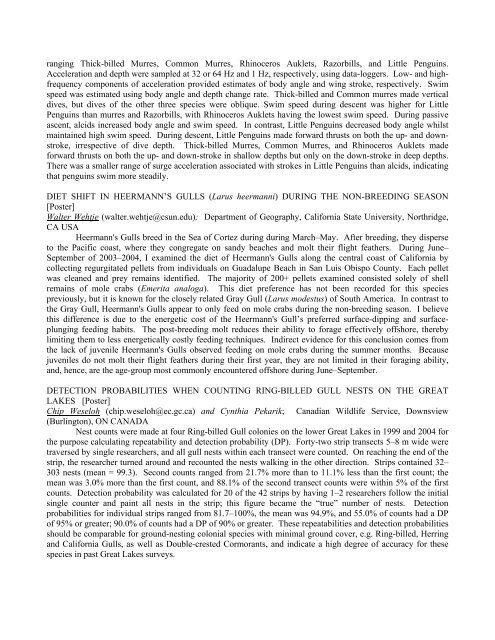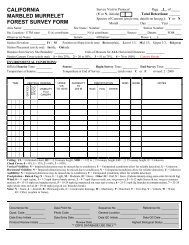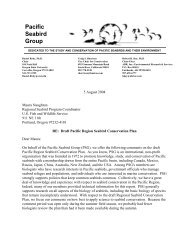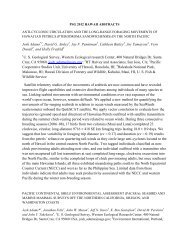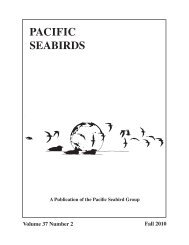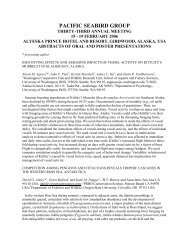abstracts of oral and poster presentations - Pacific Seabird Group
abstracts of oral and poster presentations - Pacific Seabird Group
abstracts of oral and poster presentations - Pacific Seabird Group
Create successful ePaper yourself
Turn your PDF publications into a flip-book with our unique Google optimized e-Paper software.
anging Thick-billed Murres, Common Murres, Rhinoceros Auklets, Razorbills, <strong>and</strong> Little Penguins.<br />
Acceleration <strong>and</strong> depth were sampled at 32 or 64 Hz <strong>and</strong> 1 Hz, respectively, using data-loggers. Low- <strong>and</strong> highfrequency<br />
components <strong>of</strong> acceleration provided estimates <strong>of</strong> body angle <strong>and</strong> wing stroke, respectively. Swim<br />
speed was estimated using body angle <strong>and</strong> depth change rate. Thick-billed <strong>and</strong> Common murres made vertical<br />
dives, but dives <strong>of</strong> the other three species were oblique. Swim speed during descent was higher for Little<br />
Penguins than murres <strong>and</strong> Razorbills, with Rhinoceros Auklets having the lowest swim speed. During passive<br />
ascent, alcids increased body angle <strong>and</strong> swim speed. In contrast, Little Penguins decreased body angle whilst<br />
maintained high swim speed. During descent, Little Penguins made forward thrusts on both the up- <strong>and</strong> downstroke,<br />
irrespective <strong>of</strong> dive depth. Thick-billed Murres, Common Murres, <strong>and</strong> Rhinoceros Auklets made<br />
forward thrusts on both the up- <strong>and</strong> down-stroke in shallow depths but only on the down-stroke in deep depths.<br />
There was a smaller range <strong>of</strong> surge acceleration associated with strokes in Little Penguins than alcids, indicating<br />
that penguins swim more steadily.<br />
DIET SHIFT IN HEERMANN’S GULLS (Larus heermanni) DURING THE NON-BREEDING SEASON<br />
[Poster]<br />
Walter Wehtje (walter.wehtje@csun.edu); Department <strong>of</strong> Geography, California State University, Northridge,<br />
CA USA<br />
Heermann's Gulls breed in the Sea <strong>of</strong> Cortez during during March–May. After breeding, they disperse<br />
to the <strong>Pacific</strong> coast, where they congregate on s<strong>and</strong>y beaches <strong>and</strong> molt their flight feathers. During June–<br />
September <strong>of</strong> 2003–2004, I examined the diet <strong>of</strong> Heermann's Gulls along the central coast <strong>of</strong> California by<br />
collecting regurgitated pellets from individuals on Guadalupe Beach in San Luis Obispo County. Each pellet<br />
was cleaned <strong>and</strong> prey remains identified. The majority <strong>of</strong> 200+ pellets examined consisted solely <strong>of</strong> shell<br />
remains <strong>of</strong> mole crabs (Emerita analoga). This diet preference has not been recorded for this species<br />
previously, but it is known for the closely related Gray Gull (Larus modestus) <strong>of</strong> South America. In contrast to<br />
the Gray Gull, Heermann's Gulls appear to only feed on mole crabs during the non-breeding season. I believe<br />
this difference is due to the energetic cost <strong>of</strong> the Heermann's Gull’s preferred surface-dipping <strong>and</strong> surfaceplunging<br />
feeding habits. The post-breeding molt reduces their ability to forage effectively <strong>of</strong>fshore, thereby<br />
limiting them to less energetically costly feeding techniques. Indirect evidence for this conclusion comes from<br />
the lack <strong>of</strong> juvenile Heermann's Gulls observed feeding on mole crabs during the summer months. Because<br />
juveniles do not molt their flight feathers during their first year, they are not limited in their foraging ability,<br />
<strong>and</strong>, hence, are the age-group most commonly encountered <strong>of</strong>fshore during June–September.<br />
DETECTION PROBABILITIES WHEN COUNTING RING-BILLED GULL NESTS ON THE GREAT<br />
LAKES [Poster]<br />
Chip Weseloh (chip.weseloh@ec.gc.ca) <strong>and</strong> Cynthia Pekarik; Canadian Wildlife Service, Downsview<br />
(Burlington), ON CANADA<br />
Nest counts were made at four Ring-billed Gull colonies on the lower Great Lakes in 1999 <strong>and</strong> 2004 for<br />
the purpose calculating repeatability <strong>and</strong> detection probability (DP). Forty-two strip transects 5–8 m wide were<br />
traversed by single researchers, <strong>and</strong> all gull nests within each transect were counted. On reaching the end <strong>of</strong> the<br />
strip, the researcher turned around <strong>and</strong> recounted the nests walking in the other direction. Strips contained 32–<br />
303 nests (mean = 99.3). Second counts ranged from 21.7% more than to 11.1% less than the first count; the<br />
mean was 3.0% more than the first count, <strong>and</strong> 88.1% <strong>of</strong> the second transect counts were within 5% <strong>of</strong> the first<br />
counts. Detection probability was calculated for 20 <strong>of</strong> the 42 strips by having 1–2 researchers follow the initial<br />
single counter <strong>and</strong> paint all nests in the strip; this figure became the “true” number <strong>of</strong> nests. Detection<br />
probabilities for individual strips ranged from 81.7–100%, the mean was 94.9%, <strong>and</strong> 55.0% <strong>of</strong> counts had a DP<br />
<strong>of</strong> 95% or greater; 90.0% <strong>of</strong> counts had a DP <strong>of</strong> 90% or greater. These repeatabilities <strong>and</strong> detection probabilities<br />
should be comparable for ground-nesting colonial species with minimal ground cover, e.g. Ring-billed, Herring<br />
<strong>and</strong> California Gulls, as well as Double-crested Cormorants, <strong>and</strong> indicate a high degree <strong>of</strong> accuracy for these<br />
species in past Great Lakes surveys.


